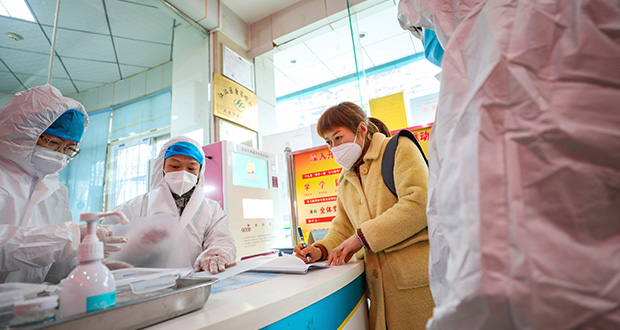Authorities have identified five cases of the Wuhan coronavirus in Australia – four from NSW and one from Victoria. Globally there have been 2014 confirmed cases: 1985 in China and the rest in the Western Pacific Region, South East Asia, the US and France.
Scientifically identified as ‘novel coronavirus (2019-nCoV)’, so far we know very little. But we do know this outbreak is the first known instance of the disease found in humans.
What is it?
Coronaviruses (CoV) are a large family of viruses that cause illness from the common cold to more severe diseases such as Middle East Respiratory Syndrome (MERS-CoV) and Severe Acute Respiratory Syndrome (SARS-CoV), and this particular strain causes pneumonia-like symptoms.
According to the World Health Organization (WHO), the main clinical signs and symptoms reported in this outbreak include fever, difficulty in breathing, and “chest radiographs showing bilateral lung infiltrates”.
WHO suggests that not enough is currently known about the full clinical features of the disease, nor the intensity of the human-to-human transmission and the original source of the outbreak. However, early theories suggest that, like SARS, the virus may come from bats.
“It’s these coronaviruses like SARS and MERS, and this new one, that when they jump species from bats or some other vertebrate host into humans, they can be quite virulent,” says Roy Hall, professor of virology at the Australian Infectious Diseases Research Centre.
This can make these types of viruses unpredictable, and it can be difficult to pin down how long an outbreak might last.
“In the case of SARS, it came, it was explosive, it was highly transmissible. We had a roughly 10 per cent mortality rate … but it disappeared after six months and we haven’t been able to find the exact virus again in nature, and why it suddenly died out we don’t know,” Hall says.
“With MERS, it’s a different story; there is the odd case,” he says.
“We have no idea what this virus is going to do.”
Writing in The Conversation, Sanjaya Senanayake from the Australian National University, said that if this virus behaves like MERS or SARS, then droplets of saliva, urine, faeces and blood could all be infectious.
“This is why prompt isolation of suspected cases and good infection control practices are so important,” he said.
How did it occur?
WHO was first alerted to the outbreak on 31 December last year when several reports of pneumonia in Wuhan City, capital of Hubei Province in China, did not match any other known virus.
Modelling by Australian academics working with the WHO suggests that one carrier may infect 2.5 to 3 people, which would suggest this virus is less infectious than both the previous outbreaks of MERS and SARS.
There is currently no vaccination for this strand of the coronavirus, however scientists at the University of Queensland have been asked to use its new ‘molecular clamp’ technology, created by UQ scientists in partnership with CEPI, to produce a vaccine available worldwide within six months.
“The University of Queensland’s molecular clamp technology provides stability to the viral protein that is the primary target for our immune defence,” said Dr Keith Chappell, from UQ’s School of Chemistry and Molecular Biosciences and the Australian Institute for Bioengineering and Nanotechnology.
“The technology has been designed as a platform approach to generate vaccines against a range of human and animal viruses and has shown promising results in the laboratory targeting viruses such as influenza, Ebola, Nipah and MERS coronavirus.”
What next?
Chinese authorities have imposed travel bans on several Chinese cities near Wuhan, affecting more than 41 million people. Schools in the Hubei province, currently on break for the Lunar New Year, have postponed their return indefinitely in attempt to stop the spread.
Here in Australia, some private schools are telling parents to keep children home if they have travelled to China unless they are medically cleared to come in. However, the health department says that children are fine to attend school as long as they have not come into contact with a confirmed case of the virus.
Currently, the Australian Federal Department of Health has advised there is no need for alarm in Australia at this stage.
The Royal Australian College of General Practitioners (RACGP) is urging GPs to watch for patients with fever and respiratory symptoms returning from "specific" travel to Wuhan.
The WHO has advised against the application of any restrictions of international traffic based on the information currently available on this event.
Smart Traveller recommends that if you need to travel to any area with confirmed cases of the virus, talk to your doctor before travelling with children, if you are pregnant or have a weak immune system, and read the travel advice for the destination as well as the relevant advice about infectious diseases on its website.
As for further outbreak, Hall believes Australia is well placed to deal with any cases that present themselves.
“Medical practitioners and nurses had to prepare for the outcome of Ebola coming to Australia, so we know that Australia has contingencies set up for really good isolation and quarantine of patients with highly transmissible viruses. They’ll have similar systems in place, and they’ll know how to protect themselves against an infectious disease.”
Do you have an idea for a story?Email [email protected]
 Aged Care Insite Australia's number one aged care news source
Aged Care Insite Australia's number one aged care news source

